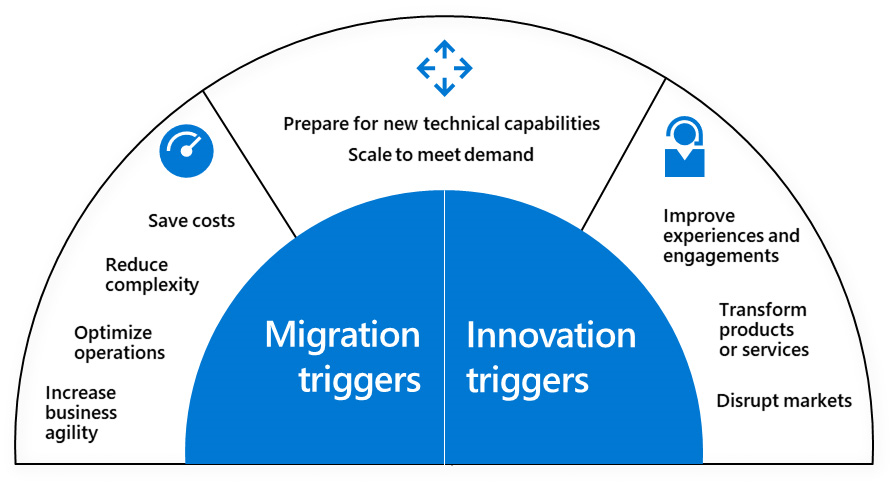Define strategy
Organizations adopt the cloud to help drive business transformation, such as processes and product improvement, market growth, and increased profitability. Let's look at the most common motivation triggers for cloud adoption.
Across organizations of all types, sizes, and industries, the decision to invest in cloud technologies is often tightly connected to a critical business event. The reason for this connection is because the cloud might enable the appropriate solution for the event. Proper cloud technology implementation might turn a reactive response into an innovation opportunity to drive growth for the organization.
![]()
Watch this video to learn more.
Motivations
Organizations find different triggers to adopt new technologies like Azure. Some triggers drive the organization to migrate current applications. Other triggers require creation of new capabilities, products, and experiences.
Some common migration and innovation triggers include:
- Preparation for new technical capabilities
- Gaining scale to meet market or geographic demands
- Cost savings
- Reduction in vendor or technical complexity
- Optimization of internal operations
- Increased business agility
- Improvements to customer experiences or engagements
- Transformation of products or services
- Disruption of the market from new products or services


There are many reasons or triggers for cloud adoption. Which triggers are most relevant to your business? Where do you see the most opportunity to take advantage of the benefits of cloud technology? Identifying these opportunities will help you develop your cloud adoption plan.
Strategy
When you define your cloud business strategy, you should consider business impact, turnaround time, global reach, performance, and more. Here are key areas you need to focus on:
- Establish clear business outcomes: Drive transparency and engagement for your journey across the organization.
- Define business justification: Identify business value opportunities to then select the right technology.
Implementing the first application is key to learning and testing with confidence, as your cloud adoption journey starts. Use a two-pronged approach to select it:
- Business criteria: Identify an application currently in operation where the owner has a strong motivation to move to the cloud.
- Technical criteria: Select an application that has minimum dependencies and can be moved as a small group of assets.

The first application an organization deploys to the cloud is often done so in an experimental environment with no operational or governance capacity. It's important to select an application that doesn't interact with secure data. Carefully consider which application is a good candidate. As you plan subsequent releases and additional applications are deployed to the cloud, you create the first prioritized migration application and the first prioritized release backlog. Over time, you create and continue to shape the optimal environment for future deployments.
Establish clear business outcomes
The most successful cloud adoption journeys start with a business outcome in mind, backed up by financial reasoning and support. A business outcome is a concise, defined, and observable result or change in business performance that's captured by a specific measure. The cloud strategy team consists of business leaders from finance, IT infrastructure, and application groups. The team leads the cloud analysis and planning phase. In this phase, the cloud strategy team is responsible for:
- Reviewing business outcomes and creating the business justification plan for possible use cases for cloud adoption.
- Building or facilitating the cloud rationalization process, selecting the first application, and managing subsequent prioritized backlogs.
- Managing communications with key stakeholders and promoting the cloud adoption journey success and learnings.
Remember that the chief financial officer (CFO) can be a key player in creating and landing a cloud adoption plan and can drive the value of migration and innovation, including creating a financial plan for adoption.
Here are some tools to support you in your financial planning:
- Azure Total Cost of Ownership (TCO) Calculator: Use the TCO calculator to estimate the cost savings you can realize by migrating your application workloads to Azure.
- Azure pricing calculator: Estimate your expected monthly bill by using the pricing calculator.
- Microsoft Cost Management + Billing: Use and manage Azure and other cloud resources through a multiple-cloud cost management solution.
Tip
Links to the TCO calculator, Azure pricing calculator, and Microsoft Cost Management + Billing tools are available in the Summary and resources unit at the end of this module.
Define business justification
Developing a clear business justification for cloud adoption with tangible, relevant costs and returns can be a complex process. First, review some common cloud computing business value areas to help justify the cloud adoption journey:
- Cost: Eliminates capital expense.
- Scale: Ability to scale elastically, delivering the right amount of IT resources
- Productivity: Removes the need for many IT management chores
- Reliability: Eases the burden of data backup, disaster recovery, and business continuity

Here are the key points from this unit:
- Motivations for cloud adoption include:
- Migration triggers, such as cost saving and operations optimization.
- Innovation triggers, such as scaling to meet market or geographical demands.
- The Cloud Adoption Framework for Azure enables an actionable cloud journey that rapidly delivers on the desired business outcomes.
- The key areas to focus on when you develop your cloud business strategy are to:
- Define your business justification by identifying business value opportunities.
- Establish clear business outcomes to drive transparency and engagement.
- Microsoft provides tools to support you in your financial planning:
- Azure total cost of ownership calculator
- Azure pricing calculator
- Microsoft Cost Management + Billing
- Your first adoption project should align with your motivations for adoption.
Now that you've learned about how to define your business outcomes and overall strategy for cloud adoption, let's get started and create a plan for this journey.